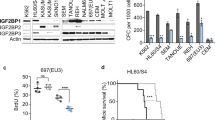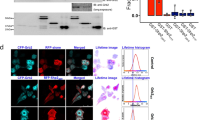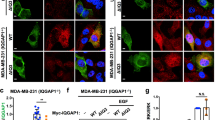Abstract
It has been demonstrated that proline-rich nuclear receptor coregulatory protein (PNRC) is a nuclear receptor coactivator that interacts with nuclear receptors through an SH3-binding motif located in its C-terminus. In the present report, a physical interaction between PNRC and Grb2 (an adapter protein involved in growth factor/Ras-mediated pathways) has been demonstrated using the GST pull-down assay, the yeast two-hybrid assay, as well as by coimmunoprecipitation. Cotransfection and fluorescence imaging have also confirmed the colocalization of PNRC and Grb2 in mammalian cells. Transient transfection experiments have demonstrated that, by interacting with each other, Grb2 decreases the coactivator activity of PNRC for nuclear receptors, and that PNRC suppresses Grb2-mediated Ras/MAP-kinase activation. Furthermore, it was discovered that HeLa cells overexpressing PNRC grew more slowly when compared to matched controls. Additionally, using a RT–PCR analysis of mRNA on six pairs of cancer/noncancer tissues, PNRC expression was found to be significantly lower in breast cancer tissue than in noncancer tissue. Based on these findings, we believe that PNRC and Grb2, by interacting with each other, can suppress nuclear receptor-mediated regulation and growth factor-mediated regulation in human breast tissue. This is a newly identified crosstalk mechanism for modulating these two important types of regulatory pathways.
This is a preview of subscription content, access via your institution
Access options
Subscribe to this journal
Receive 50 print issues and online access
$259.00 per year
only $5.18 per issue
Buy this article
- Purchase on Springer Link
- Instant access to full article PDF
Prices may be subject to local taxes which are calculated during checkout







Similar content being viewed by others
References
Chen S, Zhou D, Yang C and Sherman M . (2001). J. Biol. Chem., 276, 28465–28470.
Cheng AM, Saxton TM, Sakai R, Kulkarni S, Mbamalu G, Vogel W, Tortorice CG, Cardiff RD, Cross JC, Muller WJ and Pawson T . (1998). Cell, 95, 793–803.
Cussac D, Vidal M, Leprince C, Liu WQ, Cornille F, Tiraboschi G, Roques BP and Garbay C . (1999). FASEB J., 13, 31–38.
DeMore JF and Brown M . (2000). Mol. Cell. Biol., 20, 5041–5047.
Gay B, Suarez S, Caravatti G, Furet P, Meyer T and Schoepfer J . (1999). Int. J. Cancer, 83, 235–241.
Glass CK, Rose DW and Rosenfeld MG . (1997). Curr. Opin. Cell Biol., 9, 222–232.
Harris RA, Eichholtz TJ, Hiles ID, Page MJ and O'Hare MJ . (1999). Int. J. Cancer, 80, 477–484.
Heery DM, Kalkhoven E, Hoare S and Parker MG . (1997). Nature, 387, 733–736.
Horwitz KB, Jackson TA, Bain DL, Richer JK, Takimoto GS and Tung L . (1996). Mol. Endocrinol., 10, 1167–1177.
Kato S, Endoh H, Masuhiro Y, Kitamoto T, Uchiyama S, Sasaki H, Masushige S, Gotoh Y, Nishida E and Kawashima H . (1995). Science, 270, 1491–1494.
Lowenstein EJ, Daly RJ, Batzer AG, Li W, Margolis B, Lammers R, Ullrich A, Skolnik EY, Bar-Sagi D and Schlessinger J . (1992). Cell, 70, 431–442.
Nelson RM and Long GL . (1989). Anal. Biochem., 180, 147–151.
Nicholson RI and Gee JWM . (1996). Hormone and Cancer, Vedeckis WV (ed). Birkhauser: Boston, pp 227–261.
Ordentlich P, Downes M and Evans RM . (2001). Curr. Top. Microbiol. Immunol., 254, 101–116.
Pawson T . (1995). Nature, 373, 573–580.
Rauh MJ, Blackmore V, Andrechek ER, Tortorice CG, Daly R, Lai VK, Pawson T, Cardiff RD, Siegel PM and Muller WJ . (1999). Mol. Cell. Biol., 19, 8169–8179.
Rooij JD and Bos JL . (1997). Oncogene, 14, 623–625.
Russell KS and Hung MC . (1992). Cancer Res., 52, 6624–6629.
Tari AM, Hung MC, Li K and Lopez-Berestein G . (1999). Oncogene, 19, 1325–1332.
Verbeek BS, Adriaansen-Slot SS, Rijksen G and Vroom TM . (1997). J. Pathol., 183, 195–203.
Zhou D and Chen S . (2001). Nucleic Acids Res., 29, 3939–3948.
Zhou D, Quach KM, Yang C, Lee SY, Pohajdak B and Chen S . (2000). Mol. Endocrinol., 14, 986–998.
Acknowledgements
We are grateful to Dr Peter S McPherson, Montreal Neurological Institute, McGill University for pGEX2T-Raf/RBD expression plasmid. This research was supported by NIH Grants DK60560 and CA44735. Bin Chen was supported by Chinese National Nature Foundation Grant 30300126.
Author information
Authors and Affiliations
Corresponding author
Rights and permissions
About this article
Cite this article
Zhou, D., Chen, B., Ye, JJ. et al. A novel crosstalk mechanism between nuclear receptor-mediated and growth factor/Ras-mediated pathways through PNRC–Grb2 interaction. Oncogene 23, 5394–5404 (2004). https://doi.org/10.1038/sj.onc.1207695
Received:
Revised:
Accepted:
Published:
Issue Date:
DOI: https://doi.org/10.1038/sj.onc.1207695
Keywords
This article is cited by
-
Frequent genetic differences between matched primary and metastatic breast cancer provide an approach to identification of biomarkers for disease progression
European Journal of Human Genetics (2010)



